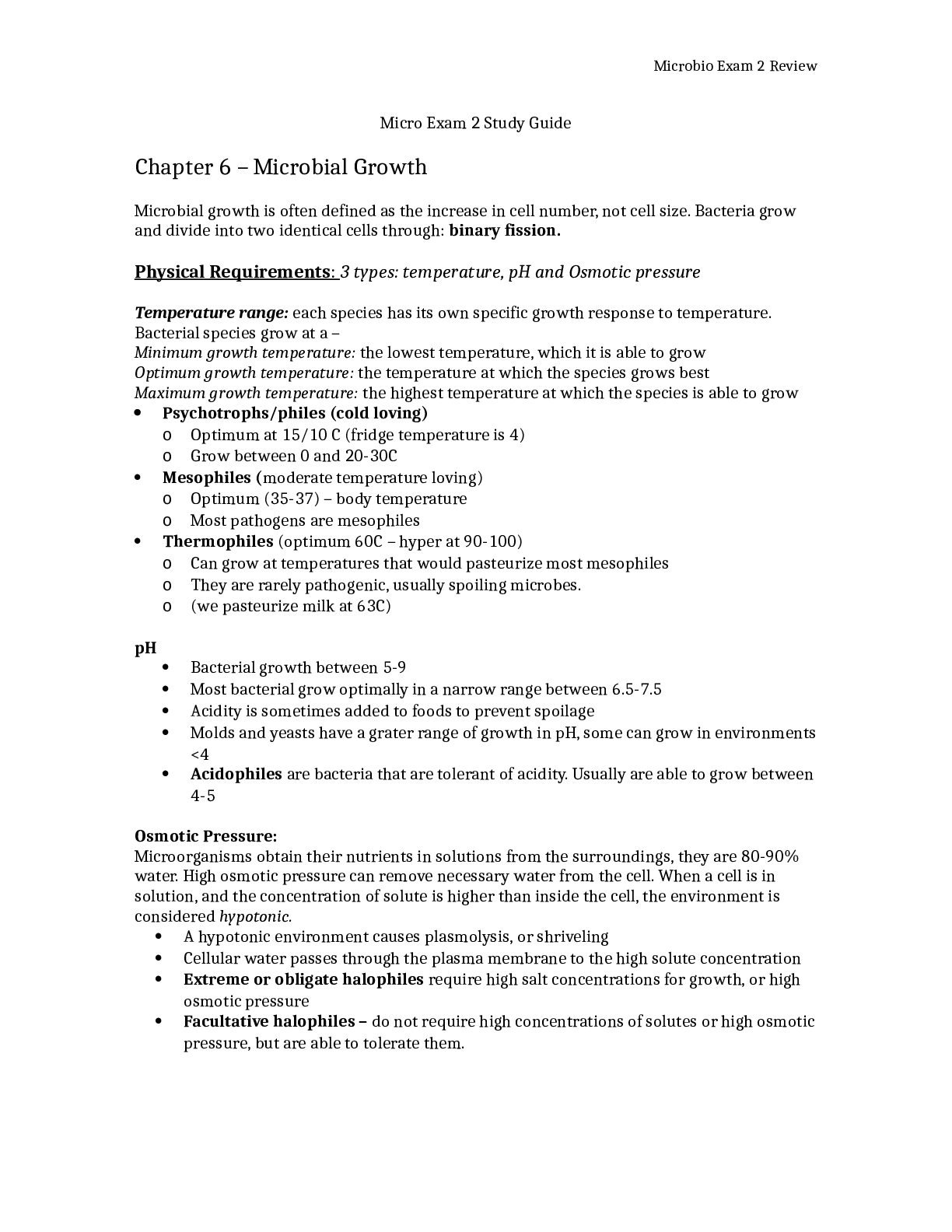Chapter 6 – Microbial Growth
Microbial growth is often defined as the increase in cell number, not cell size. Bacteria grow
and divide into two identical cells through: binary fission.
Physical Requirements: 3 types: temperature, pH and Osmotic pressure
Temperature range: each species has its own specific growth response to temperature.
Bacterial species grow at a –
Minimum growth temperature: the lowest temperature, which it is able to grow
Optimum growth temperature: the temperature at which the species grows best
Maximum growth temperature: the highest temperature at which the species is able to grow
Psychotrophs/philes (cold loving)
o Optimum at 15/10 C (fridge temperature is 4)
o Grow between 0 and 20-30C
Mesophiles (moderate temperature loving)
o Optimum (35-37) – body temperature
o Most pathogens are mesophiles
Thermophiles (optimum 60C – hyper at 90-100)
o Can grow at temperatures that would pasteurize most mesophiles
o They are rarely pathogenic, usually spoiling microbes.
o (we pasteurize milk at 63C)
pH
Bacterial growth between 5-9
Most bacterial grow optimally in a narrow range between 6.5-7.5
Acidity is sometimes added to foods to prevent spoilage
Molds and yeasts have a grater range of growth in pH, some can grow in environments
<4
Acidophiles are bacteria that are tolerant of acidity. Usually are able to grow between
4-5
Osmotic Pressure:
Microorganisms obtain their nutrients in solutions from the surroundings, they are 80-90%
water. High osmotic pressure can remove necessary water from the cell. When a cell is in
solution, and the concentration of solute is higher than inside the cell, the environment is
considered hypotonic.
A hypotonic environment causes plasmolysis, or shriveling
Cellular water passes through the plasma membrane to the high solute concentration
Extreme or obligate halophiles require high salt concentrations for growth, or high
osmotic pressure
Facultative halophiles – do not require high concentrations of solutes or high osmotic
pressure, but are able to tolerate them.
Microbio Exam 2 Review
Chemical Requirements for Growth: carbon, nitrogen, sulfur, phosphorus, trace
elements, oxygen and organic growth factors.
Carbon
Besides water, one of the most important requirements for microbial growth is carbon it
is the structural backbone of living matter, it is needed for all organic compounds that
make up a cell. Almost half of the dry weight of a microbe is carbon
It is a structural organic molecule, as well as an energy source
Chemoheterotrophs – use organic carbon sources such as proteins, carbs lipids.
Autotrophs – derive their carbon from CO2
Nitrogen
Amino acid and protein synthesis requires nitrogen
Most bacteria decompose proteins
Some bacteria use nitrogen from ammonium (NH4+) or nitrate (NO3-)
Very few use N2 in nitrogen fixation
Sulfur
Used in amino acids: thiamine and biotin
Most bacteria decompose proteins
Use SO42- or H2S as a source
Phosphorus
Used in DNA RNA and ATP synthesis as well as membranes
PO43- is a source
Trace Elements:
Microbes require very small amounts of other inorganic minerals referred to as trace
elements.
Most are essential for the functions of certain enzymes and act as COFACTORS
Carbon, Hydrogen, Oxygen, Phospohorus, Potassium, Iodine, Nitrogen, Sulphur,
Calcium, Iron, Sodium, Chlorine, Magnesium, Manganese, Zinc.
C.HOPKINS CaFe – Mighty nice Mighty good.
Oxygen:
Read More
.png)

